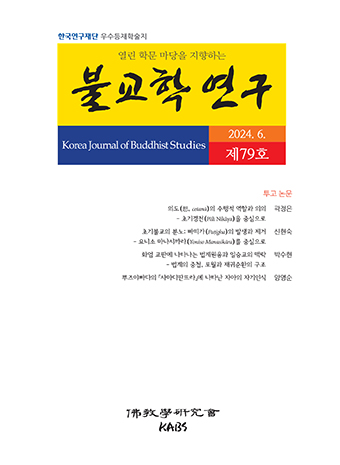Abstract
References
Sorry, not available.
Click the PDF button.
Information
Previous research on the kanhwasŏn 看話禪 practice has only considered the Yiqing(疑情) raising concerning the hwadu 話頭. This paper distinguishes and examines two kinds of Yiqing raising: the subjective(主體的) and the intentional(意圖的) one. Subjective Yiqing raising is concerned with the awareness of fundamental problems Such as life and death, and characterized by life’s defiled nature(煩惱性). Intentional Yiqing raising is concerned with hwadus and characterized by its pure nature(淸淨性). The reason for distinguishing between the two kinds of Yiqing raising is the need to analyze the psychological phenomena of practice and understand its course from a subjective view point. These two types of Yiqing raising may be in a relation of opposition, conflict or amalgation(融合). While opposition and conflict are states of disharmony, the state of unity is one of mutual harmonization. The awakening of Master Pojo Chinul(普照知訥, 1158-1210) may be understood as two stepped. The first step, before he knew kanhwasŏn doctrine, was an awakening relying upon(依) subjective Yiqing raising. The second step, after the Master encountered kanhwasŏn doctrine, was an awakening concerning(對) subjective Yiqing raising. The awakening relying upon subjective doubt raising took place at the level of both the meditative(禪門) and the scriptural(敎門). The awakening concerning subjective Yiqing raising was an awakening to the nature of subjective Yiqing raising and a liberation from it, achieved as he was reading the Record of Master Taehye Chonggo(大慧宗杲, 1089-1163). The encounter of subjective and intentional Yiqing raising experienced by Chinul is the characteristic of his kanhwasŏn. This means that Chinul acknowledged the value of an awakening achieved through subjective Yiqing raising. Chinul has also demonstrated that intentional Yiqing raising about the hwadu allows the objectivization of subjective Yiqing raising and, ultimately, the overcoming of Yiqing raising itself.
기존 연구에서 간화선의 의정은 화두에 대한 의정으로만 간주하고 연구되어져 왔다. 이 논문에서는 주체적 의정과 의도적 의정으로 나누어서 고찰하고자 한다. 주체적 의정은 생사와 같은 근원적인 문제의식이고 그 특징은 번뇌성이다. 의도적 의정은 화두에 대한 의정이며 그 특징은 청정성이다. 이와 같이 의정을 구분하는 이유는 수행의 주체적 입장에서 수행심리적 현상을 분석하고, 그의 수행과정을 이해하기 위해서이다. 두 의정의 관계는 대립, 충돌, 융합으로 나타난다. 대립과 충돌은 의정의 조화를 이루지 못한 상태이고, 융합은 서로 조화를 이룬 상태이다. 보조지눌(普照知訥, 1158-1210)의 깨달음은 두 단계의 깨달음으로 볼 수 있다. 첫째는 간화선 사상을 알기 전에 ‘주체적 의정에 의(依)한 깨달음’이다. 둘째는 간화선 사상을 알고 난 후에 ‘주체적 의정에 대(對)한 깨달음’이다. 주체적 의정에 의한 깨달음은 주체적 의정에 의해서 수행을 해 나간 것이고, 선문과 교문에서 깨달음을 얻은 것이다. 주체적 의정에 대한 깨달음은 주체적 의정, 그 자체를 깨닫고서 그것으로부터 벗어난 것이며, 『대혜어록』을 보면서 깨달음을 얻은 것이다.지눌이 경험한 주체적 의정과 의도적 의정의 만남은 지눌의 간화선의 특징이다. 즉, 지눌은 주체적 의정에 의한 깨달음을 긍정하였다. 그리고 화두에 대한 의도적 의정으로써 주체적 의정을 객관화시켜서 궁극적으로는 의정 그 자체로부터 벗어나게 만든다는 것을 잘 보여준다.
Click the PDF button.
- Publisher :Korean Association of Buddhist Studies
- Publisher(Ko) :불교학연구회
- Journal Title :Korea Journal of Buddhist Studies
- Journal Title(Ko) :불교학연구
- Volume : 25
- No :0
- Pages :81 ~ 133


 Korea Journal of Buddhist Studies
Korea Journal of Buddhist Studies






